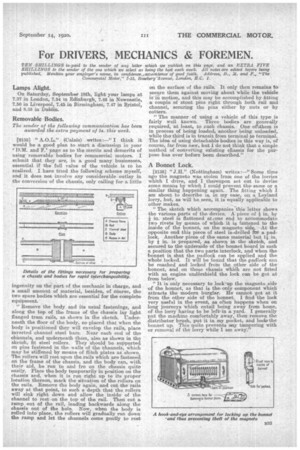For DRIVERS, MECHANICS & FOREMEN.
Page 27

If you've noticed an error in this article please click here to report it so we can fix it.
TEN SHILLINGS is-paid to the sender of any letter which we publish on this page, and an EXTRA. FIVE SHILLINGS to the sender of the one which we select as being the best each week. All notes are edited before being published. Mention your employer's name, in confidence.,as>eoidernce of good faith. Address, 13., Al. and F., "T'he Commercial Motor," 7-15, Bosebery-Avenue, London, EX. 1.
Lamps Alight.
On Saturday, September 18th, light your lamps at 7.37 in London, 7.54 in Edinburgh, 7.46 in Newcastle, 7.50 in Liverpool, 7.45 in Birmingham, 7.47 in Bristol, and 8.33 in Dublin.
Removable Bodies.
The sender of the following communication has been awarded the extra payment of 5s. this week.
[135] " A.O.L." (Calais) writes:—" I think it would be a good plan to start a discussion in your D.M. and F.' page as to the merits and demerits of using removable bodies for commercial motors. I submit that they are, in a good many businesses, essential if the full value of the vehicle is to be realized. I have tried the following scheme myself, and it does not involve any considerable outlay in the conversion of the chassis, only calling for a little ingenuity on the part of the mechanic in charge, and a small amount of material, besides, of course, the two spare bodies which are essential for the complete equipment.
"Remove the body and its usual fastenings, and along the top of the frame of the chassis lay light flanged tram rails, as shown in the sketch. -Underneath the floor of the body, soplaced that when the body is positioned they will envelop the rails, place inverted channel steel bars. Near each end of the channels, and underneath them, also as shown in the sketch, fit steel rollers. They should be supported on pins fastened in the walls of the channels, which may be stiffened by means of flitch plates as shown. The rollers will rest upon the rails which are fastened on the frame of the chassis, and the body can, with their aid, be run to and fro on the chassis quite easily. Place the body temporarily in position on the chassis and, when it is run right up to its proper location thereon, mark the situation of the rollers, on the rails. Remove the body again and cut the rails away at that point, to such a depth that the rollers will sink right down and allow the inside of the channel to rest on the top of the rail. Then cut a ramp out of the rail, leading backwards along the chassis out of the hole. Now, when the body is rolled into place, the rollers will gradually run down the ramp and let the channels come gently to rest on the surface of the rails. It only then remains to secure them against moving about while the vehicle is motion, and this may be accomplished bylitting a couple of stout pins right through both rail and channel, securing the pins either by nuts or by cotters.
"The manner of using a vehicle of this type is fairly well known. Three bodies are generally required, at least, to .each chassis. One ofetheni is in Process of being loaded, another being unloaded, while the third is in transit from terminal to terminal. The idea of using detachable bodies in this way is, of course, far from new, but I do not think that a simple method of convertiog eieisting chassis for the purpose has ever before been described."
A Bonnet Lock.
{2136] " J.II." (Nottingham) writes Some time ago the magneto was stolen from one of the lorries which I drive, and I thereupon set out to devise some means by which I could prevent th& same or a similar thing happening again. The fitting which I am about to describe a s , in my case on a Leyland lorry, but, as will be Been, it is equally applicable to other makes.
"The sketch which accompanies this letter shows the various parts of the device. A piece of in. by i I in. steel s flattened ateone end to accommodate two rivets by means. of which it is fastened to the inside of the bonnet, on the magneto side, At the opposite end this piece of steel is-drilled fur a padlock. Another piece of the same material but lie in. by in. is prepared, as shown in the sketch, and secured to the underside of the bonnet board in such a position that the two parts interlock, and when the bonnet is shut the padlock can be applied and the whole locked. It will be found that the padlock can be reached and locked from the other side of the bonnet, and on those chassis which are not fitted with an engine undgrshieId the lock can be got at from below.
"It is only necessary to lockup the magneto side of the bonnet, as that is the only component which attracts the modern burglar. He cannot get at it from the other side of the bonnet. I find the lock very useful in the event, as often happens when on long journeys which entail being away from home, of the lorry having to be lefein a yard. I generally put the machine comfortably away, then remove the distributor brush, put it in my pocket, and lockithe bonnet up. This quite prevents any tampering with or removal of the lorry while I am away."




























